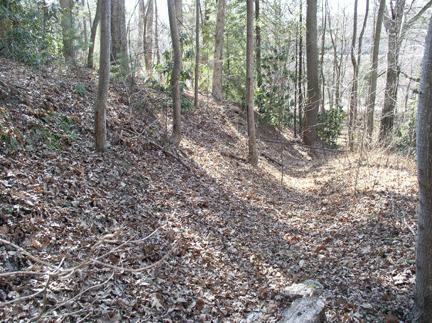Asheville, Battle of
 One of the last Civil War actions, the Battle of Asheville was a five-hour standoff between Union and Confederate forces that occurred on the northern outskirts of the city during the afternoon and evening of 6 Apr. 1865. The site of Confederate recruitment camps and a rifle factory, Asheville had once aspired to be the "capital of the Confederacy" because of its geographic centrality. Yet it was spared in Federal raids from East Tennessee until the war's final month. Col. Isaac B. Kirby led 900 Union troops of the 101st Ohio Infantry from Greeneville, Tenn., into North Carolina, moving down the French Broad Valley with orders to "scout in the direction of Asheville, N.C." Along the way, Kirby's men burned bridges, stole horses, confiscated rations, and added Confederate deserters to their ranks. Only as they reached the Sondley and Woodfin farms within four or five miles of Asheville were local residents alerted to their approach.
One of the last Civil War actions, the Battle of Asheville was a five-hour standoff between Union and Confederate forces that occurred on the northern outskirts of the city during the afternoon and evening of 6 Apr. 1865. The site of Confederate recruitment camps and a rifle factory, Asheville had once aspired to be the "capital of the Confederacy" because of its geographic centrality. Yet it was spared in Federal raids from East Tennessee until the war's final month. Col. Isaac B. Kirby led 900 Union troops of the 101st Ohio Infantry from Greeneville, Tenn., into North Carolina, moving down the French Broad Valley with orders to "scout in the direction of Asheville, N.C." Along the way, Kirby's men burned bridges, stole horses, confiscated rations, and added Confederate deserters to their ranks. Only as they reached the Sondley and Woodfin farms within four or five miles of Asheville were local residents alerted to their approach.
Confederate colonel George Clayton, stationed in the city as an administrator of the state's Western District, mustered a force of 300 Confederates. Some were regular troops home on leave and the rest were Home Guardsmen. An additional 175 remaining members of Clayton’s 62nd North Carolina Infantry supplemented their forces. They moved out of the city with two small brass Napoleon cannons in time to encounter Kirby's forces on a field previously fortified with trenches and earthworks beside the French Broad River. When Kirby's force reached the Confederates, he quickly ordered his soldiers to a safe distance and behind trees. At about 3 P.M., the Confederates opened fire on the approaching Union soldiers, and for several hours, the forces shot at each other with little result. The intense fire led Kirby to order “the withdrawal of the brigade at 8 P.M." According to Kirby, the trenches and cannon fire seem to have led the Ohioans to assume that they faced a more formidable force than was actually the case. Kirby also received false reports listing 2,000 men and 20 cannons in Asheville, with reinforcements moving in from surrounding areas. Darkness and stormy weather led him to abandon further efforts to take Asheville; instead, he ordered his men to retreat. No one on either side was killed, and only two to four soldiers were wounded in the exchange. The retreat by Union forces provided a Confederate tactical victory.
The local victory proved short-lived. Two weeks later Maj. Gen. George H. Stoneman's cavalry raid, which moved through western North Carolina and Virginia in March and April, approached Asheville, moving west from Burke and McDowell Counties. Although no official word of Robert E. Lee's surrender at Appomattox had reached either Stoneman or local Confederates, both sides agreed on 24 April that Union forces would march unchallenged through Asheville en route back to Tennessee. But the same Federal troops returned to Asheville a day later, this time pillaging the town, burning the armory, and harassing both male and female residents.
References:
John G. Barrett, The Civil War in North Carolina (1963).
F. A. Sondley, A History of Buncombe County, North Carolina, vol. 2 (1930).
Additional Resources:
"Battle of Asheville: American Civil War." Thomaslegion.net. Accessed April 18, 2023 at http://www.thomaslegion.net/battleofasheville.html.
"Battle of Asheville: Kirby's expedition." Civil War Trails, Inc., North Carolina Library for the Blind and Physically Handicapped. 2008. Accessed April 18, 2023 at https://digital.ncdcr.gov/documents?search=Battle%20of%20Asheville%3A%20Kirby's%20expedition&searchtypes=Metadata|Full%20text&applyState=true
Image Credit:
Site of Battle of Asheville. Courtesy of NC Markers, North Carolina Office of Archives & History. Available from https://www.ncdcr.gov/about/history/division-historical-resources/nc-highway-historical-marker-program/Markers.aspx?MarkerId=PPP-1 (accessed May 16, 2012).
1 January 2006 | Inscoe, John C.